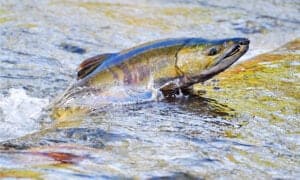Salmon are key to sustaining the health of Earth’s river ecosystems: they provide food for multiple species (including humans and bears), distribute nutrients into rivers and oceans when they die, and the nitrogen released during spawning encourages tree growth. Salmon can also get very big, with the largest salmon ever weighing almost 100 pounds. More on this below, but here’s a preview in pictures:

Salmon species are also revered by some Northwest Native American tribes, as a large part of their diet, history, and culture. Like most animals that are hunted for food, over-harvesting has led to declines, despite commercial hatcheries working hard to stabilize the numbers locally. Salmon are also well known for their migrations. The newly hatched salmon must swim downstream (in some cases all the way to the ocean) until they reach maturity. Once ready, they swim upstream once more to where they were born, spawn, and then die. This perilous journey has been the subject of quite a few nature documentaries and is made harder by the presence of hydroelectric dams blocking the upstream passage.
Recently, many old and ineffective dams have been removed in the Pacific Northwest region to open up the rivers to the salmon’s natural habitat. There are seven species of salmon in the world today (along with a recently discovered bonus), and they are listed below in order from smallest to largest. For this article, salmon are measured in inches for length and pounds for weight.
Bonus: Kunimasu Salmon
How shocked would you be if you stumbled upon a species thought to be extinct for more than 70 years? That’s what happened to the Kunimasu salmon (Oncorhynchus kawamurae), which was native to Lake Tazawa in north-central Japan until 1940 when construction of a hydroelectric dam killed off the fish. Attempts to relocate the fish in 1935 were thought to be unsuccessful, but in 2010, the Kunimasu was rediscovered in Lake Saiko (some 300 miles to the south). They are listed as extinct in the wild since the native population today was only possible due to human interference; there are an estimated 2,600 of them living in Lake Saiko.
Dietary and habitat information is lacking with regard to the Kunimasu as research is still forthcoming. They are, however, the smallest salmon entry on our list, growing to just over a foot in length. The Kunimasu had been classified previously as a subspecies of the sockeye salmon before being separated into its own species. In a world of dwindling wild animals, it’s always nice to know that some thought-to-be extinct species managed to survive.
7. Masu Salmon
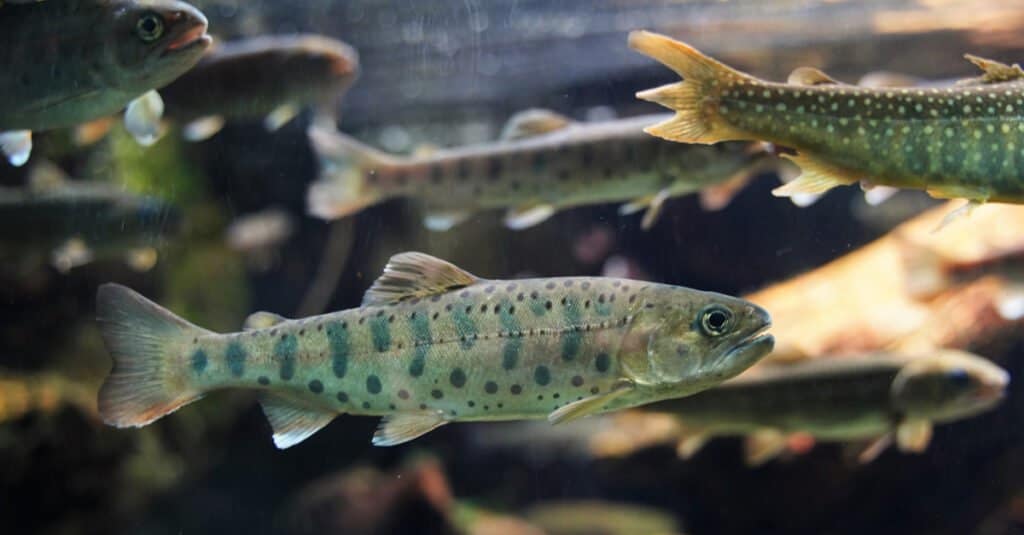
Unlike other salmon, young masu can stay in their spawning area for up to three seasons before migrating.
©dokosola/Shutterstock.com
| Average Size | Maximum Observed |
|---|---|
| 20 inches, 4.4-5.5 lbs | 28 inches, 20 lbs |
The Masu Salmon (Oncorhynchus masou) is the dominant salmon in the northern Pacific Ocean near East Asia, with a habitat ranging from Siberia to Korea, Taiwan, and Japan. Like other salmon, a Masu usually dies after spawning and can live for up to 3.5 years. Unlike other salmon, young masu can stay in their spawning area for up to three seasons before migrating to the ocean.
The Masu is also known as the cherry salmon because stripes along its body become red and crimson when the salmon reaches maturity. There are a few subspecies of the Masu, including some that are anadromous (born in freshwater, spend their life in seawater, and spawns back in freshwater) and freshwater, or land-locked varieties. The IUCN currently lists them as endangered.
6. Pink Salmon
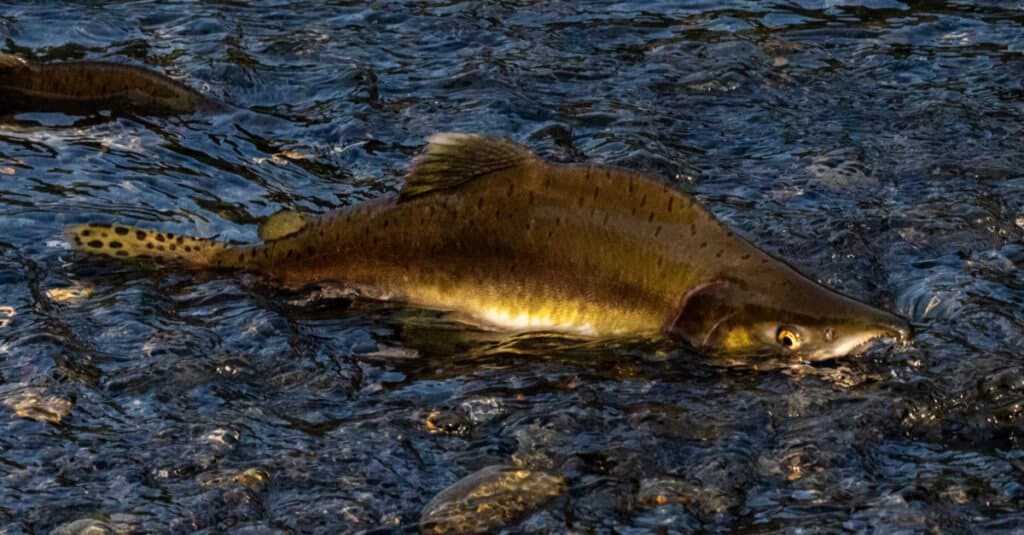
Pink salmon changes its appearance throughout its life, developing a distinctive humpback shape.
©Mark A. McCaffrey/Shutterstock.com
| Average Size | Maximum Observed |
|---|---|
| 20-25 inches, 3-5 lbs | 30 inches, 15 lbs |
Also known as the humpback salmon, Pink salmon (Oncorhynchus gorbuscha) is the most abundant salmon in the Pacific Ocean. It is generally referred to as the smallest of the North American Pacific salmon. The native range is large, with the salmon occurring from as far south as the Sacramento River, all the way north to the Mackenzie River, in Canada’s Northwest Territories. Occasionally, a Pink Salmon will be sighted even further south, like in the Salinas river in 2014 and Lagunitas Creek (25 miles north of San Francisco) in 2017.
This species changes colors and appearance often throughout its life, eventually developing a very large hump and hooked jaws. According to the Alaska Dept. of Fish and Game, pink salmon young aren’t naturally buoyant. They have to swim up to the surface and gulp down bubbles of air into their swim bladder to stop from sinking. Because pink salmon weren’t listed under the endangered species act, they don’t have a conservation status with IUCN; however, other conservation organizations like NatureServe list the population as stable with regional variations (critically imperiled in California).
5. Sockeye Salmon
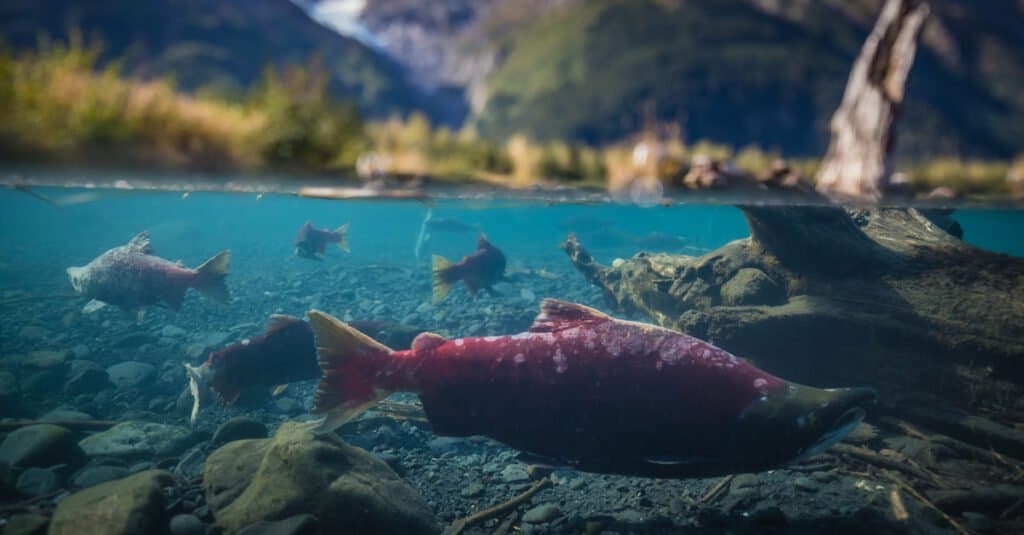
The world’s biggest sockeye run occurs near Bristol Bay, Alaska.
©907Shots/Shutterstock.com
| Average Size | Maximum Observed |
|---|---|
| 21-26 inches, 4-7 lbs | 15 lbs, 3 oz |
One of the more distinguishable varieties on the list, the Sockeye Salmon (Oncorhynchus nerka) is silver in the ocean and turns bright red during its journey back to its spawning grounds. The fish has also been featured in numerous nature documentaries due to its extravagant migrations (or runs), which can end up covering over 1,000 miles. Not all populations migrate to the ocean; land-locked sockeyes are known as kokanee and are generally much smaller than the anadromous variety.
The sockeye salmon eats primarily zooplankton and has long been a staple of human cuisine as well. Sockeye numbers are generally declining, but they have a strong presence in several regions and watersheds. The largest sockeye run in the world occurs near Bristol Bay, Alaska; in 2021, 63.2 million fish returned to the bay.
4. Coho Salmon

The Coho has traditionally lived on both sides of the Pacific Ocean.
©Keith Publicover/Shutterstock.com
| Average Size | Maximum Observed |
|---|---|
| 24-28 inches, 5-10 lbs | 33 lbs., 7 oz |
The Coho (Oncorhynchus kisutch) is a large variety of pacific salmon; it has silver sides and a dark-blue back during its ocean phase. Like other salmon, during the spawn, the physiology and color of the Coho change, developing hooked jaws and red skin. Traditionally, the Coho has lived on both sides of the Pacific Ocean. More recently, it has been introduced to the Great Lakes and many other reservoirs in the U.S.
Most Coho return to spawn after three years, although, occasionally, smaller two-year-old males will as well. The two-year-olds are called “jack males” and aren’t seen as a threat by the older, larger salmon. When larger Coho fight over spawning territory, the jack male will sometimes swim over the eggs of the female and fertilize them while the other males are distracted. Scientists have dubbed this the “sneaking” method.
3. Chum Salmon

Typical of salmon, Chum salmon changes when swimming upstream and develops a
tiger
stripe pattern of red and black.
©The Old Major/Shutterstock.com
| Average Size | Maximum Observed |
|---|---|
| 24-31 inches, 6.5-12.5 lbs | 44 inches, 42 lbs |
The Chum Salmon (Oncorhynchus keta) is also known as dog salmon, keta salmon, calico salmon, and silverbite salmon. It is an anadromous fish living over a wide range in and near the Pacific Ocean. They have one of the longest migrations of the salmon and journey far up the Yukon River and Amur River. Chum salmon appear metallic greenish-blue along their backs with black speckles, making them similar to Coho and sockeye. Typical of salmon, they change drastically when swimming upstream, eventually developing a tiger stripe pattern of red and black. Males also develop large, canine-like fangs and a calico color pattern. Chum salmon generally live for 3-5 years, dying shortly after participating in a spawn.
2. Atlantic Salmon
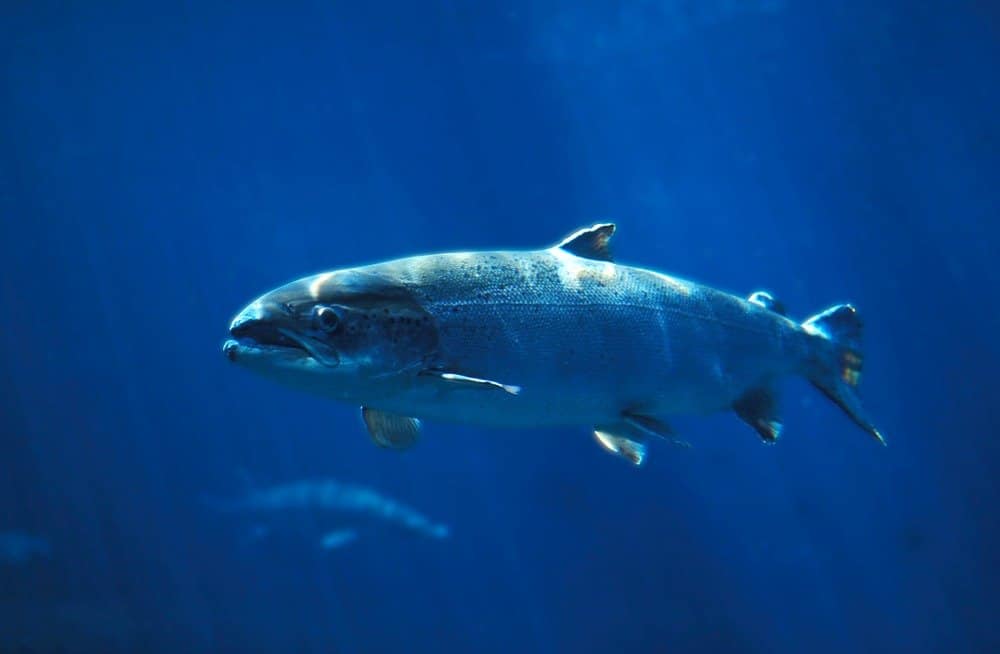
Atlantic salmon is the only species of salmon that is present in North America.
©slowmotiongli/Shutterstock.com
| Average Size | Maximum Observed |
|---|---|
| 28-30 inches, 8-12 lbs | 63.25 inches, 74 lbs |
Belonging to the same scientific family Salmonidae, this large fish is the only salmon species in the North Atlantic and can be found off the coasts of Canada, the U.S., and Europe. Similar to other salmons, most populations are anadromous. Unlike the Pacific salmons, the Atlantic doesn’t always die after spawning and can return for multiple years.
When the Atlantic salmon (Salmo salar) live in freshwater, they have blue and red spots; when they reach maturity, the spots change to a silver-blue covering. Currently, they are listed as of Least Concern by the IUCN but have not been reassessed since 1996. Restoration efforts are underway in Lake Ontario and many rivers of the Northeast. In Europe, the Atlantic salmon is listed as vulnerable by the IUCN.
1. Chinook/King Salmon
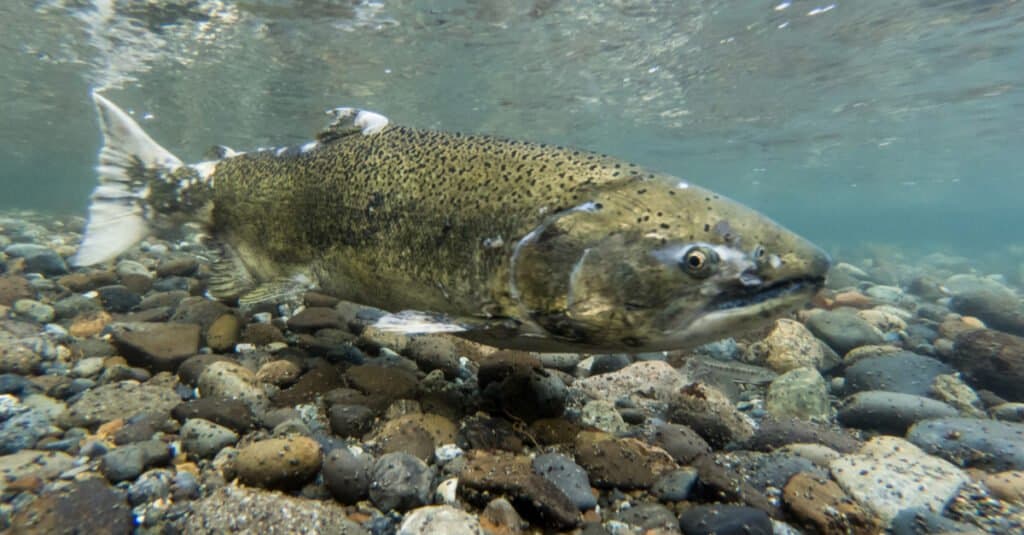
The Chinook is the biggest salmon species in the world and is prized for its nutritional value.
©Kevin Cass/Shutterstock.com
| Average Size | Maximum Observed |
|---|---|
| 36 inches, 30-38 lbs. | 58 inches, 97 lbs. |
Aptly named, the King or Chinook salmon (Oncoryhnchus tshawytscha) is the largest species of salmon on Earth. It had a wide natural distribution and has been introduced successfully to regions near New Zealand, the Great Lakes, and Patagonia. The fish is highly prized for its nutritional value, containing high levels of omega-3 fatty acids.
The conservation status of this species has not been assessed by the IUCN. Some watershed populations seem to be declining, while others appear stable and healthy. In the Kenai River, the salmon averages around 37 lbs, but the largest sport-caught salmon clocked in at 97 lbs. Chinooks in the Yukon River have the largest freshwater migration route in the world, traveling 1,900 miles from the mouth of the river to Whitehorse, Yukon.
Similar to many other salmon, the Chinook develops a pronounced jaw hook called a kype as it nears spawning but may spend as many as eight years in the ocean before returning to its spawning river. Interestingly, a Chinook’s birthplace can be tracked using its ear bone, much like tree rings reveal information about a tree’s age. The bone, called an otolith, records the chemical composition of the water the fish spawns in, revealing an evolutionary timeline for that specific salmon.
The World Record Salmon: The Biggest Ever Caught!
The world record salmon is a 97 pound Chinook salmon caught in Soldotna, Alaska in 1985. The massive salmon measured more than 58 inches long! Now, like most world records, the biggest salmon has controversies and other contenders for the title. For example, several salmon that have been caught and released have claimed to compete with the record, but world records rely on official measurements. There’s another claim of a Chinook that reached up to 125 pounds, but this wasn’t verified.
Salmon Controversies
What would a list of animals be without some controversy? The species of salmon listed above are often grouped together with steelhead trout. As the USGS explains, while the steelhead shares a lot of similarities with salmon, they are capable of repeat spawning and do not die afterward. This important life cycle difference means it is not technically a salmon. There are also a few varieties of fish that are called salmon but do not have the same characteristics as salmon; these include the Australian salmon, Danube salmon, Hawaiian salmon, and Indian salmon.
Dam destruction is a big point of contention in areas with traditionally large salmon populations because of their upstream life cycle. The dams block natural migration routes and compromise species, so many organizations are working to dismantle old and ineffective dams. Larger damns, like the Bonneville, have constructed fish ladders, which are designed to mimic an area of rapids. The ladders allow the salmon to swim up and over the dam. While successful, they also attract other predators (like sea lions) due to the high concentration of salmon on the ladder.
Summary of 7 Largest Salmon on Earth
| Number | Salmon | Average Size | Maximum Observed |
|---|---|---|---|
| 1 | Chinook/King Salmon | 36 in., 30-38 lbs. | 58 in., 97 lbs. |
| 2 | Atlantic Salmon | 28-30 in., 8-12 lbs. | 63.25 in., 74 lbs. |
| 3 | Chum Salmon | 24-31 in., 6.5-12.5 lbs. | 44 in., 42 lbs. |
| 4 | Coho Salmon | 24-28 in., 5-10 lbs. | 33 lbs., 7 oz. |
| 5 | Sockeye Salmon | 21-26 ins., 4-7 lbs. | 15 lbs., 3 oz |
| 6 | Pink Salmon | 20-25 in., 3-5 lbs. | 30 in., 15 lbs. |
| 7 | Masu Salmon | 20 in., 4.4-5.5 lbs. | 28 in., 20 lbs. |
The photo featured at the top of this post is © Rocksweeper/Shutterstock.com
Thank you for reading! Have some feedback for us? Contact the AZ Animals editorial team.




